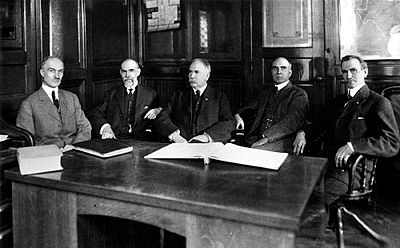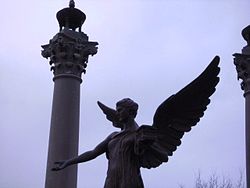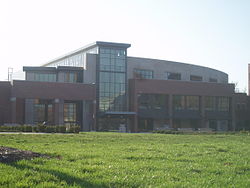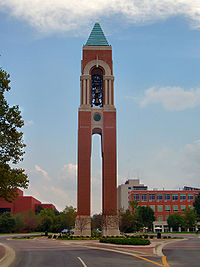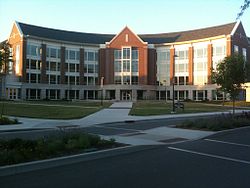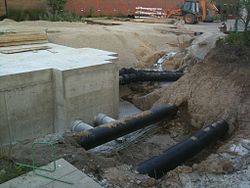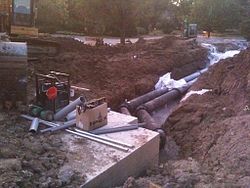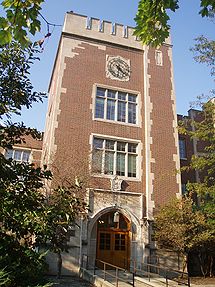- Ball State University
-
Ball State University 
Motto Education Redefined Established 1918 (details) Type Public coeducational Endowment US $134.3 million[1] President Jo Ann M. Gora Provost Terry S. King Academic staff 950 Students 22,083 Undergraduates 18,127 Postgraduates 3,956 Location Muncie, Indiana, U.S. Campus 731 acres (2.96 km2) Former names Indiana Normal School - Eastern Division
Ball Teachers College
Ball State Teachers College
Ball State CollegeColors Cardinal and White Sports 19 Division I / IA NCAA Nickname Ball State Cardinals Mascot Charlie Cardinal Website www.bsu.edu Ball State University is a state-run research university located in Muncie, Indiana. It is also known as Ball State or simply BSU.
Located on the northwest side of the city, Ball State's campus spans 731 acres (2.96 km2) and includes 106 buildings.[2] The student body consists of more than 22,000 students, of whom nearly 4,000 are graduate students.[3]
Originally a normal school, Ball State has grown and expanded over the years. Ball State is classified by the Carnegie Classification of Institutions of Higher Education as a Research University (RU/H).[4]
History
Ball State University was not the first school to operate at its location. Previous educational institutions operated at the intersection of University and McKinley Avenues before 1918; however, they were neither public nor did they carry the "Ball" name.
The pre-Ball years
The area of Muncie, Indiana that is now known as Ball State University had its start in 1899 as a private school called the Eastern Indiana Normal School to educate teachers. The entire school, including classrooms, library, and the president's residence were housed in what is now known as the Ball State Administration building.
The one-building school had a peak enrollment of 256 and charged $10 for a year's tuition. It operated until the spring of 1901, when it was closed by its president, F.A.Z. Kumler, due to the lack of funding. A year later, in the autumn of 1902, the school reopened as Palmer University for the next three years when Francis Palmer, a retired Indiana banker, gave the school a $100,000 endowment.
Between 1905 and 1907, the school dropped the Palmer name and operated as the Indiana Normal College. It had two divisions, the Normal School for educating teachers and the College of Applied Sciences. The school had an average enrollment of approximately 200 students. Due to a diminishing enrollment and lack of funding, school president Francis Ingler closed Indiana Normal College at the end of the 1906–07 school year.
Between 1907 and 1912 the campus sat vacant. In 1912, a group of local investors led by Michael Kelly reopened the school as the Indiana Normal Institute. To pay for updated materials and refurbishing the once-abandoned Administration Building, the school operated under a mortgage from the Muncie Trust Company. Although the school had its largest student body with a peak enrollment of 806, officials could not maintain mortgage payments, and the school was forced to close once again in June 1917 when the Muncie Trust Company initiated foreclosure proceedings.
Ball Brothers intervene
On July 25, 1917, the Ball Brothers, local industrialists and founders of the Ball Corp., bought the Indiana Normal Institute from foreclosure. For $35,100, the Balls bought the Administration Building and surrounding land bordered by University, McKinley, Riverside, and Tillotson Avenues, except the northwest quadrant which was maintained as a wildlife preserve (Christy Woods).
In early 1918, during the Indiana General Assembly's short session, state legislators accepted the gift of the school and the land by the Ball Brothers. The state granted operating control of the Muncie Campus and school buildings to the administrators of the Indiana State Normal School in Terre Haute. That same year, the Marion Normal Institute relocated to Muncie, adding its resources to what would officially be named the Indiana State Normal School, Eastern Division. Incidentally, the former Marion Normal Institute's campus was purchased in 1919 by what would become Indiana Wesleyan University, currently the largest private university in Indiana.
The close relationship between the Balls and the school led to an unofficial moniker for the college as many students, faculty and local politicians casually referred to the school as "Ball State" as a shorthand alternative to its longer, official name. During the 1922 short session of the Indiana legislature, the state renamed the school as Ball Teachers College. This was in recognition to the Ball family's continuing beneficence to the institution. During this act, the state also reorganized its relationship with Terre Haute and established a separate local board of trustees for the Muncie campus.
In 1924, Ball Teachers College's trustees hired Benjamin J. Burris as the first president of the state-funded college. The Ball brothers continued giving to the university and partially funded the construction of the Science Hall (now called Burkhardt Building) in 1924 and an addition to Ball Gymnasium in 1925. By the 1925–26 school year, Ball State enrollment reached 991 students: 697 women and 294 men. Based on the school's close relationship with the Ball Corporation, a long-running nickname for the school was "Fruit Jar Tech."[5]
Ball State Teachers College
During the regular legislative session of 1929, the Indiana General Assembly formally separated the Terre Haute and Muncie campuses of the state teachers college system, but it placed the governing of the Ball State campus under the Indiana State Teachers College Board of Trustees based in Terre Haute.[6] With this action, the school was renamed Ball State Teachers College. The following year, enrollment increased to 1,118, with 747 female and 371 male students.
In 1935, the school added the Arts Building for art, music, and dance instruction (now used by the Ball State University Museum of Art and the Geological Science and Social Work departments). Enrollment that year reached 1,151: 723 women and 428 men.
As an expression of the many gifts from the Ball family since 1917, sculptor Daniel Chester French was commissioned by the Muncie chamber of commerce to cast a bronze fountain figure to commemorate the 20th anniversary of the Ball brothers' gift to the state. His creation, the statue "Beneficence," still stands today between the Administration Building and Lucina Hall where Talley Avenue ends at University Avenue.
In 1961, Ball State became fully independent of Indiana State University via the creation of the Ball State College Board of Trustees, so that Ball State was no longer governed remotely by the Indiana State College Board of Trustees.[6] The official name of the school also was changed to Ball State College.
Ball State University
In 1965, in recognition of its enrollment growth (10,066 students) and for becoming more than an institution to train only public school teachers, the Indiana General Assembly renamed the school Ball State University.
Ball State has seen a trend of near-constant growth since its creation, and current enrollment is the highest in the school's history. Seven academic colleges now offer 175 bachelor's, 103 master's, and 17 doctoral degrees,[7] a sharp increase from the five degree programs initially offered by the University. The University continues a course of improving, expanding, and creating programs of study.
Campus life
Ball State's campus life revolves around two main quadrangles. The original historic quadrangle is at the south end of campus near L. A. Pittenger Student Center. The newer quadrangle is located to the north and consists of a variety of modern buildings, including Bracken Library and the cultural venue for recitals, ensembles, and films, Pruis Hall.
Despite the two quadrangles, the most heavily-utilized buildings on campus are situated along McKinley Avenue (which runs north-south) and Riverside Avenue (which runs east-west). The intersection of the two streets is nicknamed the "scramble light" after its pedestrian scramble feature. The pedestrian phase stops all traffic allowing pedestrians to cross in all directions, thus causing everyone to "scramble."
Campus architecture is primarily dominated by the use of brick buildings, with the lone exception of Pruis Hall, which is composed almost entirely of Indiana limestone. No two buildings on the campus have identical facades, which is unusual for a large university. A 2005 survey conducted by Intel Corporation rates Ball State as the number one wireless campus in the nation. Ball State's academic and administrative buildings, residence halls, and green spaces have wireless access fed by 625 Wi-Fi access points.[8]
Shafer Tower
Dedicated in 2002, Shafer Tower has become an unofficial landmark of Ball State University. It is a free-standing bell tower, or campanile, that is equipped with a carillon. It is located in the median of McKinley Avenue, in the heart of University Green.
A small staircase in the tower leads to a control room of the carillon, which has 48 custom-made bells. From here, a musician can play the instrument on special occasions or for concerts. Normally, on days which classes are held, the bells are programmed by computer to chime automatically every 15 minutes between 7:00 a.m. and 7:00 p.m.
Due to a construction defect in the type of mortar used to hold the bricks, about two-thirds of the brick on the tower had to be removed and reinstalled. The tower was, in effect, built twice. The architect of record was Edmund Hafer Associates of Evansville, Indiana.
Emens Auditorium
A cultural center for the University and the Muncie community, Emens Auditorium hosts many events annually, ranging from music concerts to Broadway musicals to guest lecturers. Built in 1964 with a capacity of 3,575, the auditorium is named for former Ball State President John R. Emens.
Bracken Library
The Alexander M. Bracken Library is the main library on the Ball State campus. It has the floor area of nearly seven American football fields and houses five floors of university offices, classrooms, computer labs, private study suites, video viewing suites, and thousands of books, videos, and audio devices available to students. Bracken Library hosts the Ball State University Digital Media Repository, an open access resource containing over 130,000 digital objects in 64 collections. Built in 1975, Bracken's most recent remodel finished in 1997.
The Bookmark Cafe, opened in January 2007, is a popular cafe and lounge area on the first floor.[9]
L. A. Pittenger Student Center
Completed in 1952, the Student Center houses the University's hotel, meeting rooms, a food court, and various forms of recreation for students, including a bowling alley. It is also home to other services, such as student programming and the University-owned campus barbershop.
In September 2006, the University rejected a proposal to build a new student center. In lieu of a new building, the University approved a remodel and expansion, which was completed recently.[10]
Ball Honors House
The Edmund F. and Virginia B. Ball Honors House is the new home of Ball State University’s Honor College. The white Colonial-style house, which was originally built in the 1930s, has undergone $1.3 million in renovations. The home is only a short distance from the DeHority Complex, which houses many Honors College students. The home has three classrooms (two of them fully technology-equipped), administrative offices for staff, a full kitchen, and private gathering areas for students. The Honors College was previous located in the basement of Carmichael Hall.[11]
Student Housing
The University currently operates ten residence complexes that house nearly 7,000 students. Ball State's freshman residence hall program is listed as one of the best in the nation by the "Unofficial, Unbiased Insider's Guide to the Most Interesting Colleges."
By far the largest housing complex is LaFollette Complex, which houses over 1,900 students. This co-ed facility, completed in 1967, has four L-shaped, eight-story units, and a ten story tower in the center that houses mainly non-traditional and international students. Johnson Complex, on the north end of campus, is a modern complex consisting of one eight-story building and two four-story buildings. The complex is the only one on campus to feature Z-shaped rooms.
In addition, Ball State has one all-female residence hall that houses approximately 600 students. The Woodworth Complex comprises four halls and also houses sorority suites.[12] In the fall of 2007, a two-story dining facility and atrium attached to the complex re-opened after two years of renovations.[13]
Of the current residence halls in operation, only one, Elliott Hall, has been in operation for most of the University's history. Constructed from 1937 to 1939, Elliott was formerly an all-male dormitory and, during World War II, housed cadets and recruits from joint programs operated by the Army and Air Force. Elliott Hall is named for Frank Elliott Ball, who died in an airplane crash while at Princeton. To commemorate and honor him, the hall is an exact replica of the one in which he lived while at Princeton. Today the hall is home to 120 co-ed students.
University Residence Halls
- DeHority Complex (Honors Halls)
- Beeman/DeMotte and Tichenor/Trane Halls
- Elliott Hall
- Johnson Complex
- Johnson A (Botsford and Swinford Halls)
- Johnson B (Schmidt and Wilson Halls)
- LaFollette Complex
- Brayton/Clevenger, Knotts/Edwards, Mysch/Hurst, Woody/Shales, Shively halls
- Kinghorn Hall (designed to meet LEED certification standards)[14]
- Noyer Complex
- Howick/Williams and Baker/Klipple Halls
- Park Hall (designed to meet LEED certification standards)[15]
- Studebaker Complex
- Studebaker West (Palmer/Davidson and Painter/Whitcraft Hall)
- Studebaker East (Menk/Hurlbut Halls)
- Woodworth Complex
- Brady/Wood and Crosley/Rogers Halls [16]
- Wagoner Complex (Houses Indiana Academy for Science, Mathematics, and Humanities Students)(Burkhardt and Jeep Halls)
In addition to the residence halls, two apartment complexes operated by the University provide affordable homes for single students and students with families. Apartments are available in one- and two-bedroom styles, and townhouses are available in two- and three-bedroom styles. The apartments are located close to campus, shopping, restaurants, entertainment, and schools.
Three of Ball State's taller residence halls – Lafollette, Johnson B, and Studebaker East – have unusual elevator systems because the halls were early co-ed dorms. As such, their elevators serve only two floors: the first floor lobby and the sixth floor lobby, which duplicates the first floor almost exactly. This served to separate the male and female portions of the dormitory, as the stairs pass through lobby doors.
Honor Societies
Greek life
History
Fraternities and sororities have been active on the Ball State campus since 1919, but this date was chosen due to an inaccuracy in records. It could be said that Greek-letter organizations at Ball State date back to 1905 with the founding of Indiana Normal School and College of Applied Science, Ball State's predecessor. Historical records are not specific regarding the number of Greek-letter organizations founded during this time. However, records show that, in 1907 the president, Francis M. Ingler decreed all fraternities to be disbanded. This was decided after a cow was discovered roaming through the Phi Sigma Theta fraternity house. Indiana Normal School and College of Applied Science also closed in 1907.
The Eastern Branch of the Indiana State Normal School, which later became Ball State University, opened in 1918. The Girls Club started within a year of the school's founding. This followed in the tradition of the organization at Indiana State Normal School in Terre Haute. All girls were eligible to become club members. Local sororities started in sections of the club beginning with Alpha sorority in 1920, which later became Alpha Chi Omega. With the inaccuracy of records before the Girls club's founding, Ball State University celebrates 1919 as the founding year for the Greek community at Ball State.
The Navajo social club, the first men's organization at Ball State, also was founded in 1920. The club later became Lambda Chi Alpha. Ball State did not have a large collection of national organizations until the mid-1950s, as many local organizations began affiliating with national fraternities and sororities.[17]
Chapters
Ball State is home to 27 Greek organizations on campus, including 15 fraternities and 12 sororities. Around eight percent of all undergraduates are members of the Greek community, with over 1,200 students maintaining membership in a Greek organization.
Fraternities
Member fraternities of National Pan-Hellenic Council (NPHC)
Member fraternities of Interfraternity Council (IFC)
Sororities
Member sororities of Panhellenic Council (PHC)
Member sororities of National Pan-Hellenic Council (NPHC)
Professional Fraternities
- Alpha Psi Omega
- Delta Sigma Pi
- Alpha Kappa Psi
- Phi Gamma Nu
- Beta Gamma Iota
- Gamma Iota Sigma
University Village
The commercial district immediately adjacent to campus, known as University Village, plays an integral part of campus life for students who live on- and off-campus. Known informally as "The Village," the district is home to a set of shops and restaurants located immediately east of the southern part of campus. Although most of the buildings have been rebuilt over the years, The Village has existed in its present location since the early 1920s. Current businesses include Be Here Now, Village Green Records, MT Cup, White Rabbit, Art Mart, Locker Room, Wizard's Keep, Scotty's Brewhouse, and 420 Underground. Dining options include Subway, Pita Pit, Jimmy John's Gourmet Subs, Greek's Pizzeria, The Chug, and Dill Street Bar & Grill. During the heated 2008 Presidential primary season, President Barack Obama opened a campaign office in the heart of University Village.
Most evenings, Mark Carter, more commonly known as "the hot dog man," sells his "nearly world famous" hot dogs to patrons of the numerous bars in the village area adjacent to the BSU campus. Carter was named number fifty-one on Sports Illustrated's "The 100 Things You Gotta Do Before You Graduate" list, published in 2003.[18] Humorously enough, Carter's first name is erroneously listed as James in the accompanying article. For a time, Carter operated a storefront location on Martin Street in The Village but returned to his original method of selling from a cart at the intersection of Dill Street and University Avenue several years ago. Carter's most popular item is the chili cheese dog, although he also offers bratwurst, Italian, and polish sausages.
Other campus features
The Cow Path, a north-south pedestrian pathway, extends along part of the western border of the campus from the Johnson residence halls to Riverside Avenue, passing to the west of the McKinley Avenue buildings. At one time, it also linked the intersection of Neely and McKinley Avenues, cutting a trail across a grassy field on which the Bell Building now stands.
The newest academic building on campus is the David Letterman Communication and Media Building, named for Ball State's arguably most famous alumnus. It was dedicated during a ceremony on September 7, 2007, with Letterman as the guest of honor.[19]
The tallest structure on campus is Shafer Tower. The tallest habitable building is Teachers College, which, at 138 feet (42 m), is also the tallest building in Muncie.
Two streets located in close proximity to campus, named Ball and Dicks, have their street signs stolen at least once each academic year. Just off campus, the High Street sign often is missing as well.
Sustainability
In 2011 the Sustainable Endowments Institute gave Ball State a College Sustainability Report Card grade of "C+."[20] President Jo Ann Gora was one of the founding members of the American College and University Presidents Climate Commitment, an initiative taken by several colleges to address climate change and reduce greenhouse gas emissions on their campuses.[21] Recognized by Kiwi Magazine in the 2008 Green College Report,[22] Ball State requires all new campus constructions to meet LEED certification standards and diverts 20% of its waste from landfills through its recycling efforts. The University also invests extensively in hybrid vehicles, hybrid-electric shuttle buses, and vehicles that use E85 for its transportation needs.[23]
At the Spring 2009 Commencement, President Jo Ann M. Gora, alongside Indiana Senator Richard Lugar, announced Ball State's plan for the nation's largest geothermal energy project.[24] Ball State has committed to reducing greenhouse gas emissions by nearly 80,000 tons annually through the installation of the $65 million geothermal heating and cooling system and the closing of all four coal-fired boilers on campus. Expected to save the University $2 million in fuel costs annually, the system will consist of 4,000 boreholes 4 inches (10 cm)-5 inches (13 cm) in diameter and two energy stations in two locations on campus. Approximately 1,800 of the boreholes are complete, along with the first energy station, all located on the north end of campus near the Duck Pond. The remainder of the boreholes and the second energy station will be located on the south end of campus near Christy Woods and the existing coal-fired boilers. The system will consist of two underground loops, one hot [150 °F (66 °C)] and one cold [42 °F (6 °C)], to circulate water for heating and cooling throughout campus.[25]
Satellite Campuses
Emphasizing immersive learning experiences, Ball State operates a satellite campus in Indianapolis and Muncie, as well as a number of specialized centers abroad. The Rinker Center for International Programs is responsible for maintaining these satellite campuses.
Australia Center
Second only to the London Center in popularity, one of the most popular study abroad programs is the Australia Center. Students are housed in youth camp facilities in the coastal city of Lennox, Head, Australia. Day trips to rainforests and marine reserves allow learning experiences outside the classroom, and students are also free to travel the continent on weekends and during breaks.
Costa Rica Center
In partnership with the Monteverde Rainforest Institute, the Costa Rica Center offers students a chance to combine academics with Central American customs, traditions, and values while serving the surrounding communities. Trips to the Center are offered as semester-long or 6-week terms. The former offers Spanish language classes, anthropology, history, sociology, and environmental studies, whereas the later provides credit for anthropology or in other participating departments.
Indianapolis Center
The Indianapoils Center is high-tech, interactive education, research, information, and outreach center located in downtown Indianapolis at 50 South Meridian Street.
London Centre
The oldest Ball State's international program (established in 1972), the London Center hosts 25-35 full-time students, living in the heart of London and studying under British and American professors. Residency and course loads are pre-arranged through the University and the City of Westminster College staff to provide an enjoyable, informative, and accredited catalog from which students may choose. In addition to academic and residency provisions, enrollment in the London Center includes admission to 8-10 major theatre productions and guided tours of London. Weekly day trips also are arranged to English cities and locales at the discresion of the Director appointed each semester. Destinations include Liverpool, Brighton & Hove, Canterbury Cathedral, and Stonehenge.
Prague Center
The Ball State University Prague Center is located in Prague, the breathtaking capital of the Czech Republic. The region has overcome communism and blossomed into a high-tech business gateway to Central Europe, as well as a capital of higher education, where students will be sent biannually as part of the Ball State’s newest study abroad program. Miller College of Business, along with the Rinker Center for International Programs, will host the Prague Center. The inaugural session at the Prague Center will run during the 2010 fall semester and will include weekly cultural excursions. Directed by a Miller College of Business faculty member, the center will offer classes in business as well as electives that meet Ball State’s core curriculum. These courses will be taught by Ball State faculty and local experts. Long weekends allow students the time to travel to other European countries such as Germany, Poland, Austria, and Switzerland.
Worcester Center
Created in partnership with the University of Worcester, the Worcester Center offers students an opportunity to experience the best of British life and culture while earning academic credit in liberal arts subjects. Just a few miles away from Stratford-upon-Avon, Shakespeare’s birthplace, as well as a number of bustling cities such as Birmingham, there is no shortage of activities near Worcester.
Academics
Colleges
Ball State University is academically organized into seven degree-granting colleges:[26]
College of Applied Sciences and Technology
- containing the School of Physical Education, Sport, and Exercise Science
- containing the Departments of: Family and Consumer Sciences • Industry and Technology • Military Science • Nursing • Wellness and Gerontology
College of Architecture and Planning
- offering the only public-university accredited degrees in architecture and urban planning within Indiana
- containing the Departments of: Architecture • Landscape Architecture • Urban Planning
Miller College of Business
- containing the Departments of: Accounting • Economics • Finance and Insurance • Information Systems and Operations Management • Marketing and Management
College of Communication, Information, and Media
- containing the Departments of: Communication Studies • Journalism • Telecommunications
- containing the Center for Information and Communication Sciences
College of Fine Arts
- containing the School of Music
- containing the Departments of: Art • Theatre and Dance
- containing the Ball State University Museum of Art
College of Sciences and Humanities
- containing the Departments of: Anthropology • Biology • Chemistry • Computer Science • Criminal Justice and Criminology • English • Geography • Geological Sciences • History • Mathematical Sciences • Modern Languages and Classics • Natural Resources and Environmental Management • Philosophy and Religious Studies • Physics and Astronomy • Physiology and Health Science • Political Science • Psychological Science • Social Work • Sociology • Speech Pathology and Audiology
Teachers College
- containing the Departments of: Counseling Psychology and Guidance Services • Educational Leadership • Educational Psychology • Educational Studies • Elementary Education • Special Education
Ball State University also has two non-degree-granting colleges:[26]
Honors College
- for the coordination of more rigorous classes for high-ability students
University College
- for the coordination of advising and other services
Accreditation
Ball State University has been accredited by The Higher Learning Commission of the North Central Association of Colleges and Schools continuously since 1925.[27]
Athletics
Ball State competes in the following NCAA sports[28] Men's sports Women's sports Sport Conference Sport Conference Basketball I MAC Basketball I MAC Golf I MAC Golf I MAC Swimming I MAC Swimming I MAC Tennis I MAC Tennis I MAC Volleyball I MIVA Volleyball I MAC Baseball I MAC Softball I MAC Football I MAC Soccer I MAC Field hockey I MAC Gymnastics I MAC Indoor Track & Field I MAC Outdoor Track & Field I MAC Cross country I MAC Ball State competes in the NCAA Division I / IA and is part of the Mid-American Conference (MAC) in all sports except for men's volleyball, where it competes in the Midwestern Intercollegiate Volleyball Association (MIVA).
Ball State athletics also has Cheerleading, a non-NCAA sport.
Charlie Cardinal is Ball State's anthropomorphized cardinal mascot. He is sometimes called simply "Charlie."
The Code Red Dance team performs at many BSU sporting events.
The University's two main sporting facilities are Scheumann Stadium and John E. Worthen Arena. Ball Gymnasium and Irving Gymnasium are sporting complexes open to Ball State students. Irving has undergone renovations that were completed in August 2010. Lewellen Pool is the campus aquatic center.
Notable alumni
Main article: List of notable Ball State University alumniMany Ball State graduates have gained regional, national and international attention, including U.S. Assistant Secretary of State for Near Eastern Affairs and former United States Ambassador to Lebanon, Jeffrey D. Feltman. Ball State graduates have particularly left their mark in the fields of American professional sports and popular entertainment. The most recognizable alumnus of Ball State is American television host, David Letterman, of Late Show with David Letterman on CBS. He is joined by fellow television performers, Joyce DeWitt, who played Janet Wood in the 1970s sitcom Three's Company, and Anthony Montgomery, who played Travis Mayweather on Star Trek: Enterprise on UPN. Andy Devine, character actor and comic cowboy sidekick Oct 7 1905 - Feb 18 1977 played football at the university. South Korean comedic actress Kim Suna (김선아) attended for several years before leaving Ball State for school in Japan. Stedman Graham the love interest of talk show host Oprah Winfrey also attended Ball State when receiving his masters degree.
Brady Hoke, a former Ball State football player, alumnus, and head coach from 2003–08, was hired as the 19th head coach of the University of Michigan football team on January 12, 2011. Hoke led Ball State to a school-best 12-1 record in 2008 before leaving for San Diego State, where he went 4-8 and 9-4 in 2009-10, winning the school's first bowl game in 41 years.
Many alumni from the Miller College of Business have gone on to successful business careers like Kent C. Nelson, Retired President and CEO, United Parcel Service and John Schnatter, Founder and Chairman of Papa John's Pizza restaurants.
In the field of comics, artist Jim Davis, the cartoonist creator of Garfield also is a graduate of Ball State. Sam Smith, a retired sportswriter for the Chicago Tribune, is a graduate of Ball State.
Actor Doug Jones, was the school mascot, Charlie Cardinal, during his time at BSU and has since featured in more than 25 films (including Fantastic Four: Rise of the Silver Surfer, Hellboy, Pan's Labyrinth, Men in Black II, and Batman Returns), television series, and commercials (most notably the McDonald's "Mac Tonight" campaign) and music videos. Additionally, Jones acted in "My Name is Jerry", a movie produced by Ball State's Institute for Digital Education and Entertainment.
Sportswriter Jason Whitlock currently writes for The Kansas City Star and Fox Sports with previous stints at ESPN and AOL Sports and Mike Lopresti is a national sportswriter for the Gannett News Service. Brian Collins, now a report for KXXV in Waco Texas, is best known for the viral video showing him fumbling through a Ball State sportscast. Also, Notable ESPN Producer Matt Houston hails from Ball State University. Radio sportscaster Mark Champion is a Muncie native and graduate of Ball State. He is currently the voice of the Detroit Pistons as well as the narrator of the famous I'm going to Disney World! Super Bowl commercials.
Journalist Michael Konopasek works as a general assignment reporter at the CBS affiliate, KWTV, Channel 9 in Oklahoma City. While at Ball State, Konopasek and Zachary Perlinski represented the university on national television as they were honored with being named winners of the 2010 Fox News College Challenge.[29][30]
Reality television star Dawn Swain, the Medical Expert from the G4 program Human Wrecking Balls is a graduate from Ball State University. She majored in nursing and still practices in an Intensive Care Unit in Los Angeles, CA when not participating on the program.
Several professional athletes participated in Ball State sports before turning pro. They include NFL players such as Reggie Hodges, a punter drafted in 2005 by the St. Louis Rams; Blaine Bishop, formerly of the Tennessee Titans; Brad Maynard, a punter with the Houston Texans; Bernie Parmalee, formerly of the Miami Dolphins and current tight ends coach at the University of Notre Dame;, Dante Ridgeway, a wide receiver for the New Orleans Saints, and Ed Konopasek, formerly of the Green Bay Packers. NBA players Theron Smith of the Charlotte Bobcats and Bonzi Wells of the New Orleans Hornets competed on the NCAA level at Ball State as did Major League Baseball players, including Larry Bigbie of the Los Angeles Dodgers, Bryan Bullington, pitcher for the Pittsburgh Pirates, and Thomas Howard ("Tank"), formerly of the San Diego Padres, Cincinnati Reds, and several other major league teams. Nate Davis, a former standout quarterback on the Ball State football team, was drafted in 2009 by the San Francisco 49ers.
Points of interest
- Beneficence
- Scheumann Stadium
- John E. Worthen Arena
- Shafer Tower
- Frog Baby Fountain
- LaFollette Complex
- Christy Woods
- Wheeler Orchid Collection and Species Bank
Gallery
See also
- History of Ball State University
- List of colleges and universities in Indiana
- List of Ball State University alumni
- List of Ball State University Presidents
Notes
- ^ As of June 30, 2009. "U.S. and Canadian Institutions Listed by Fiscal Year 2009 Endowment Market Value and Percentage Change in Endowment Market Value from FY 2008 to FY 2009" (PDF). 2009 NACUBO-Commonfund Study of Endowments. National Association of College and University Business Officers. http://www.nacubo.org/Documents/research/2009_NCSE_Public_Tables_Endowment_Market_Values.pdf. Retrieved March 8, 2010.
- ^ "Campus Facilities". http://cms.bsu.edu/About/FactBook/Campus.aspx.
- ^ "Students/Enrollment". http://cms.bsu.edu/About/FactBook/Enrollment.aspx.
- ^ "Carnegie Classification Ball State University Profile". http://classifications.carnegiefoundation.org/lookup_listings/view_institution.php?unit_id=150136&start_page=institution.php&clq={%22ipug2005_ids%22%3A%22%22%2C%22ipgrad2005_ids%22%3A%22%22%2C%22enrprofile2005_ids%22%3A%22%22%2C%22ugprfile2005_ids%22%3A%22%22%2C%22sizeset2005_ids%22%3A%22%22%2C%22basic2005_ids%22%3A%22%22%2C%22eng2005_ids%22%3A%22%22%2C%22search_string%22%3A%22ball+state%22%2C%22level%22%3A%22%22%2C%22control%22%3A%22%22%2C%22accred%22%3A%22%22%2C%22state%22%3A%22%22%2C%22region%22%3A%22%22%2C%22urbanicity%22%3A%22%22%2C%22womens%22%3A%22%22%2C%22hbcu%22%3A%22%22%2C%22hsi%22%3A%22%22%2C%22tribal%22%3A%22%22%2C%22msi%22%3A%22%22%2C%22landgrant%22%3A%22%22%2C%22coplac%22%3A%22%22%2C%22urban%22%3A%22%22.
- ^ Perspective (Ball State University alumni magazine), January 2005. Retrieved September 9, 2007.
- ^ a b "Indiana State University History and Traditions". Indiana State University. http://www.indstate.edu/isu_today/history_trad.htm#Eastern_Division.
- ^ "Academic Programs". Ball State University. http://cms.bsu.edu/About/FactBook/Programs.aspx. Retrieved 20 July 2011.
- ^ "Ball State University Moves To Head Of The Class In Intel’s Ranking Of The Top 50 "Most Unwired" U.S. Campuses". Intel Corporation. Archived from the original on June 26, 2006. http://web.archive.org/web/20060626235957/http://www.intel.com/pressroom/archive/releases/20051011corp.htm. Retrieved 2006-12-03.
- ^ "Bracken Library to feature cafe". Ball State University. http://www.bsu.edu/news/article/0,1370,44316--,00.html. Retrieved 2007-01-07.
- ^ "Pittenger Update on Agenda". The Ball State Daily News Online. September 15, 2006. http://www.bsudailynews.com/media/storage/paper849/news/2006/09/15/News/Pittenger.Update.On.Agenda-2279456.shtml. Retrieved 2006-11-05.
- ^ "Ball Honors House". Ball State University. 2010. http://cms.bsu.edu/Giving/Bold/Priorities/Campus/HC/HonorsHouse.aspx. Retrieved 30 January 2010.
- ^ "Woodworth Complex". Ball State University. http://www.bsu.edu/directory/buildings/default.asp?buildingcode=WO. Retrieved 2007-01-07.
- ^ Woodworth Commons reopens - NEWS
- ^ "Kinghorn Hall Features". http://cms.bsu.edu/CampusLife/Housing/Halls/Map/Kinghorn/Features.aspx.
- ^ "Park Hall Features". http://cms.bsu.edu/CampusLife/Housing/Halls/Map/ParkHall/Features.aspx.
- ^ "Alphabetical Building List". http://www.bsu.edu/map/article/0,,31447--,00.html.
- ^ "Greek Life: Our Community". Ball State University Office of Student Life. http://cms.bsu.edu/CampusLife/GreekLife/community/history.aspx. Retrieved 19 January 2010.[dead link]
- ^ "The 100 Things You Gotta Do Before You Graduate". Sports Illustrated. http://sportsillustrated.cnn.com/2003/sioncampus/09/24/100_things0930/. Retrieved 2006-12-03.
- ^ "Ball State to add Letterman name". Indianapolis Star. Archived from the original on 2007-10-07. http://web.archive.org/web/20071007160305/http://www.indystar.com/apps/pbcs.dll/article?AID=/20070730/LOCAL/70730025. Retrieved 2007-08-25.
- ^ "College Sustainability Report Card 2011". Sustainable Endowments Institute. http://www.greenreportcard.org/report-card-2011/schools/ball-state-university. Retrieved 18 July 2011.
- ^ "Mission and History". ACUPCC. http://www.presidentsclimatecommitment.org/about/mission-history. Retrieved 18 July 2011.
- ^ "2008 Green College Report". Kiwi Magazine. http://www.kiwimagonline.com/green-college-report/pdfs/GreenCollegeReport2008.pdf. Retrieved 18 July 2011.
- ^ "Green Campus". Ball State University. http://cms.bsu.edu/About/Geothermal/GreenCampus.aspx. Retrieved 18 July 2011.
- ^ "Sen. Lugar leads off country's largest geothermal energy project.". Ball State Newscenter. http://www.bsu.edu/news/article/0,1370,61916--,00.html. Retrieved 18 July 2011.
- ^ "Going Geothermal FAQ". Ball State University. https://sitecorecms.bsu.edu/en/About/Geothermal/FAQ.aspx. Retrieved 18 July 2011.
- ^ a b "Departments Grouped by College". Ball State University. http://cms.bsu.edu/Academics/CollegesandDepartments/DepartmentsGroupedbyCollege.aspx. Retrieved 27 July 2011.
- ^ "Ball State University". The Higher Learning Commission. http://www.ncahlc.org/index.php?option=com_directory&Action=ShowBasic&instid=1176. Retrieved 2006-12-03.
- ^ "Ball State University Profile". NCAA. http://web1.ncaa.org/ssLists/orgInfo.do?orgID=47. Retrieved 2007-01-02.
- ^ Konopasek Perlinski. "2010 college challenge winner". Fox News. http://video.foxnews.com/v/4159247/2010-college-challenge-winner/. Retrieved 22 June 2011.
- ^ Konopasek, Perlinski. "meet the college challenge winners". Fox News Channel. http://video.foxnews.com/v/4179783/meet-the-college-challenge-winners/. Retrieved 25 June 2011.
References
- Ball, Edmund F., From fruit jars to satellites: The story of Ball Brothers Company, Incorporated, Newcomen Society, 1960
- Ball State University, The Elisabeth Ball Collection of paintings, drawings, and watercolors: Ball State University Art Gallery, January 15-February 26, 1984, Indiana University Press, 1984, ISBN 0-915511-00-2
- Birmingham, Frederic A., Ball Corporation, the first century, Curtis Publishing, 1980, ISBN 0-89387-039-0
- Bullock, Kurt E., Ball State University: A sense of place, Ball State University Alumni Association, 1993, ISBN 0-937994-25-1
- Edmonds, Anthony O., & Geelhoed, E. Bruce, Ball State University: An Interpretive History, Indiana University Press, 2001, ISBN 0-253-34017-9
- Hoover, Dwight W., Middletown revisited, Ball State University Press, 1990, ISBN 0-937994-18-9
External links
Coordinates: 40°11′54″N 85°24′32″W / 40.1983223°N 85.40894318°W
Ball State University Academics 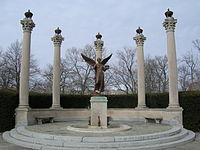
Campus Culture Beneficence • Frog Baby Fountain • Ball State Daily News • WCRD • WIPB • The Pride of Mid-America Marching Band • Museum of Art • HistoryAthletics Ball State Cardinals • Ball State Men's Basketball • Ball State Football • MAC • Irving Gymnasium • Scheumann Stadium • John E. Worthen Arena • Charlie CardinalPeople Notable Alumni • Ball Brothers • Angela Ahrendts • Bridget Bobel • Angelin Chang • Jim Davis • Joyce DeWitt • Doug Jones • David Letterman • Kent C. Nelson • John SchnatterPresidents Mid-American Conference East Division West Division Ball State Cardinals • Central Michigan Chippewas • Eastern Michigan Eagles • Northern Illinois Huskies • Toledo Rockets • Western Michigan Broncos
Affiliates Chicago State (men's tennis) • Evansville (men's swimming and diving) • Florida Atlantic (men's soccer) • Hartwick (men's soccer) • UMass (football, 2012) • Missouri State (field hockey, men's swimming and diving) • Southern Illinois (men's swimming and diving) • Temple (football)
Seasons Championships & awards Conference champions
Midwestern Intercollegiate Volleyball Association Ball State • Grand Canyon • IPFW • Lewis • Loyola • Ohio State • Quincy
Public colleges and universities in Indiana Indiana University System Purdue University System Joint IU–PU Campuses Indiana University – Purdue University Fort Wayne • Indiana University – Purdue University Columbus • Indiana University – Purdue University IndianapolisOthers Categories:- Council for Christian Colleges and Universities
- Educational institutions established in 1918
- Ball State University
- Universities and colleges in Indiana
- Association of Public and Land-Grant Universities
- American Association of State Colleges and Universities
- Muncie, Indiana
- Mid-American Conference
- Education in Delaware County, Indiana
- Consortium for North American Higher Education Collaboration
- North Central Association of Colleges and Schools
- Midwestern Intercollegiate Volleyball Association
- Buildings and structures in Delaware County, Indiana
- Visitor attractions in Delaware County, Indiana
- DeHority Complex (Honors Halls)
Wikimedia Foundation. 2010.

